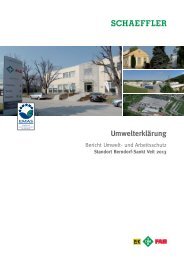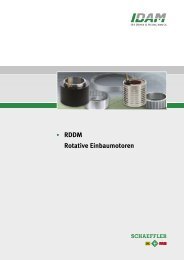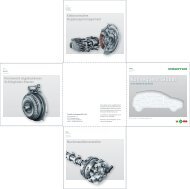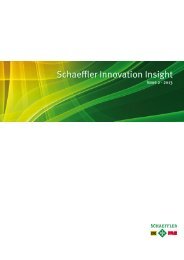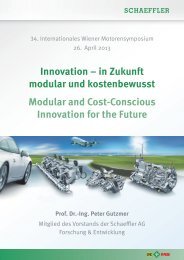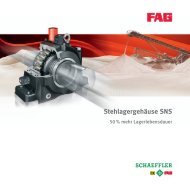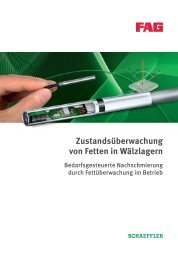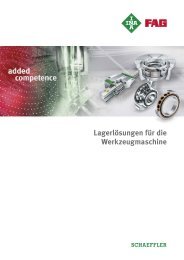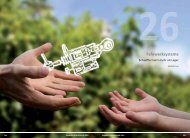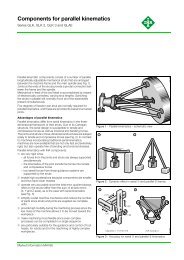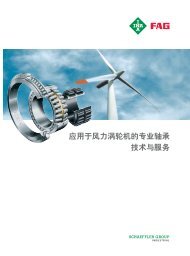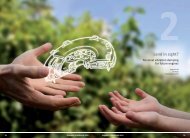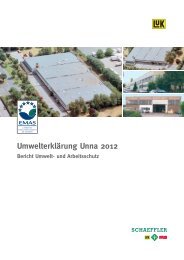Engine systems - Schaeffler Group
Engine systems - Schaeffler Group
Engine systems - Schaeffler Group
You also want an ePaper? Increase the reach of your titles
YUMPU automatically turns print PDFs into web optimized ePapers that Google loves.
<strong>Engine</strong> <strong>systems</strong>
Contents<br />
Page<br />
2 The right partner – worldwide<br />
18 Hydraulic valve lash adjustment<br />
18 Example: Tappet<br />
20 Hydraulic valve lash adjustment elements<br />
20 Example: Tappet<br />
22 Mechanical valve lash adjustment elements<br />
22 Example: Tappet<br />
24 Roller finger follower valve train components<br />
24 Hydraulic valve lash adjustment<br />
26 Rocker arm valve train components<br />
26 Hydraulic valve lash adjustment<br />
28 End pivot rocker arm valve train components<br />
28 Hydraulic valve lash adjustment<br />
30 OHV valve train components<br />
30 Hydraulic valve lash adjustment<br />
32 Crosshead valve train components<br />
32 Hydraulic valve lash adjustment<br />
34 Switchable valve lash adjustment elements<br />
34 Example: Switchable tappet<br />
36 Function: Switchable tappet<br />
40 Chain drive <strong>systems</strong><br />
40 Chains, chain sprockets<br />
40 Chain blades<br />
40 Chain guides<br />
42 Chain drive tensioners<br />
44 Cam-cam tensioners<br />
46 Belt drive <strong>systems</strong><br />
46 Primary drive<br />
50 Accessory drives<br />
56 Belt-driven starter generator drive RSG<br />
58 Tensioning <strong>systems</strong> for RSG drives<br />
60 Tension and idler pulleys for primary and accessory drives<br />
62 Variable camshaft timing <strong>systems</strong><br />
62 System description<br />
64 Solenoid valve MAGV<br />
66 Variable camshaft timing system with helical splines for chain drive NWEK<br />
68 Vane type variable camshaft timing system for chain drive NWFK<br />
70 Vane type variable camshaft timing system for belt drive NWFR<br />
72 REGE Motorenteile<br />
72 Core product: cylinder heads<br />
75 Addresses<br />
75 Automotive Division
<strong>Engine</strong> <strong>systems</strong>
The right partner – WORLDWIDE<br />
<strong>Engine</strong> <strong>systems</strong> are our business. We are a permanent partner to our customers,<br />
from the planning stage right through to service. In short, we don’t just sell a<br />
product, we offer complete solutions – WORLDWIDE.<br />
More than 30 years ago, we set our focus on the international automotive market.<br />
Today, we manufacture components and <strong>systems</strong> for valve trains, primary drives,<br />
ancillary drives and variable camshaft timing <strong>systems</strong> in countries such as Brazil,<br />
France, Britain, Germany, Romania, the USA, the Slovak Republic and the emerging<br />
markets of China and Korea.<br />
Thanks to our worldwide presence, we can assure you of our solid technical<br />
expertise, comprehensive customer support, low logistical costs and reduced<br />
currency risks.<br />
It’s important to have the right partner:<br />
■ A partner who knows your requirements and has a local presence.<br />
■ A partner like <strong>Schaeffler</strong> KG – WORLDWIDE.<br />
2
138 120c
The best solution<br />
It all started with a vision – a vision from which we developed our components<br />
for engine <strong>systems</strong> and which, over time, gained an outstanding reputation.<br />
In partnership with vehicle manufacturers on every continent, we ensure that<br />
■ Personal mobility,<br />
■ Technical progress and<br />
■ Ecological responsibility are in harmony:<br />
This is equally true for the very economical 3-cylinder engine<br />
and the high-capacity, high-performance 12-cylinder engine.<br />
4
138 121c
Market – the number ONE<br />
Principles must be proven time after time, solutions must be reviewed<br />
in a critical light and reconsidered. That is our fundamental approach and<br />
it is only in this way that innovations – such as our valve train components –<br />
have been possible.<br />
Our approach has made us a market leader:<br />
■ WORLDWIDE – with a market share of over 30% for valve train components.<br />
■ EUROPE – here we serve more than 50% of the market.<br />
Together with our customers, we are already working on solutions<br />
for the future to maintain that leadership.<br />
We remain faithful to the proven principle:<br />
■ Any result can, must and will be improved.<br />
6
World market situation 2004<br />
Others<br />
Competitor A<br />
33%<br />
Competitor B<br />
325<br />
300<br />
Sales volume per year in millions<br />
325<br />
250<br />
300<br />
200<br />
150<br />
250<br />
100<br />
200<br />
50<br />
150<br />
0<br />
1990 1991<br />
1996<br />
1992<br />
1993<br />
Quantity<br />
Valve actuation elements<br />
1994<br />
1995<br />
1997<br />
1998<br />
1999<br />
2000<br />
2001<br />
2002<br />
2003<br />
2004<br />
100<br />
50<br />
0<br />
138 119c
Success requires knowledge<br />
What began more than 30 years ago as a pioneering step with a small<br />
group of people has now developed into a separate, major product line.<br />
Accordingly, the number of employees has grown strongly.<br />
In the areas of development and design in particular, we use our<br />
best experts to develop ever more “intelligent” valvetrain <strong>systems</strong>.<br />
We will of course continue to do so, in order to meet the increasingly<br />
complex requirements of our customers and find solutions:<br />
■ INA engineering services – with expertise, local to the customer<br />
and always in the lead.<br />
8
11,0<br />
4,3<br />
Number of employees<br />
Total employees Development employees Total employees<br />
Development employees<br />
1450 38 6270 417<br />
1990<br />
2004<br />
138 122c
Simulation model<br />
Formerly, all design and testing work on the supplier’s products was carried<br />
out at the premises of the automotive manufacturer. Nowadays, responsibility<br />
for the component through to the complete control system lies with the supplier.<br />
For this reason, the <strong>Schaeffler</strong> KG (developer of INA components) has a team<br />
of highly qualified employees in the fields of development and design.<br />
They ensure that products are designed to fulfill customer requirements –<br />
starting with analysis and simulation, through testing to the application itself.<br />
Demands on “intelligent” valve trains include:<br />
■ Reduced noise<br />
■ Reduced friction<br />
■ Reduced exhaust emissions<br />
■ Reduced fuel consumption.<br />
The overall objective is:<br />
■ Valve train <strong>systems</strong> with reduced mass but increased stiffness.<br />
Our approach:<br />
■ For optimum design of our engine <strong>systems</strong>, we use state of the art analysis<br />
and simulation methods, including kinematic and kinetic calculations,<br />
finite element analyses, topological optimization and dynamic simulations.<br />
Example:<br />
■ In order to verify the design of a rocker arm valve train, we analyse<br />
the dynamic behavior with the aid of an equivalent Multi-Body-System<br />
(see figure right).<br />
10
138 193<br />
Piston<br />
Camshaft<br />
Housing<br />
Contact pad<br />
Valve<br />
Valve spring
Test set up for dynamic measurement<br />
Our engine components must fulfill customer requirements in relation<br />
to function and reliability and must thus achieve the highest quality standard.<br />
We therefore subject our products to the most thorough testing regime.<br />
Here too, as in analysis and simulation we use the most advanced technology:<br />
■ <strong>Engine</strong> test rigs, subassembly test rigs, pulsers and special equipment.<br />
Example:<br />
■ For dynamic measurement of valve trains, we use the most advanced<br />
laser measuring technology (see figure right).<br />
Measurement system<br />
Incremental encoder or clock/<br />
measurement trigger<br />
Pressure in hydraulic element<br />
Valve lift<br />
Valve velocity<br />
Valve stem force<br />
Valve spring tension<br />
A<br />
B<br />
C<br />
Wheatstone full bridge<br />
DC force amplifier<br />
Instrumented load measuring<br />
points<br />
12
A<br />
B<br />
A<br />
B<br />
F y<br />
Rotational angle generator<br />
C<br />
C<br />
Data recorder<br />
1 2 3 4 5 0<br />
C<br />
A<br />
B<br />
1<br />
Sensors<br />
2<br />
2<br />
Laser vibrometer<br />
138 192a
Valve timing drives – the 1911 patent<br />
The father of the hydraulic valve lash adjustment element, Walter Speil 1) ,<br />
recalls aspects of the history of the internal combustion engine:<br />
It was shortly after the invention of the internal combustion engine itself that<br />
imaginative inventors focused their attention on gas exchange valve drives<br />
controlled by cams. The Frenchman Amédée Bollee applied in 1911<br />
for a patent for a valve timing drive that he had already designed as<br />
a low-friction, maintenance-free system:<br />
■ Cam tracking by roller bearing<br />
■ Automatic, hydraulic valve lash compensation<br />
■ Direct valve actuation<br />
■ Camshaft driven direct via gear ratio reduction or short chain.<br />
The grave disadvantage of this valve train arrangement was the so-called “L”<br />
head engine design. The combustion chamber could not be arranged directly over<br />
the piston but extended to the valve inlets located to the sides of the cylinders.<br />
It was quickly recognized that irregularly shaped compression and combustion<br />
chamber arrangements of this type allowed only moderate levels of combustion<br />
efficiency. The combustion chambers had to be made more compact and arranged<br />
so that they were only above the piston. This was how the “standing valves”<br />
previously guided in the cylinder block came to be located in a “suspended”<br />
arrangement in the cylinder head. The camshaft remained at its<br />
original position in the cylinder block.<br />
Next followed the OHV pushrod valve trains ... for the further development<br />
of valve timing drives, see page 16.<br />
<strong>Schaeffler</strong> KG<br />
The engineers at <strong>Schaeffler</strong> KG (developer of INA products) were pioneers in the<br />
market niche for low-maintenance valve trains in high-speed internal combustion<br />
engines – with direct valve actuation by means of hydraulic tappets.<br />
Our new concept passed its first test in 1974 when it was adopted by<br />
Mercedes Benz for volume usage in the 8 cylinder engines for its luxury class<br />
vehicles – principally because of the significantly lower exhaust emissions from<br />
the lash-free valve train. At the same time, Porsche proved in preproduction tests<br />
in a race car (917) that very high speeds could be achieved with our valve trains.<br />
1) Active for many years as head of development for <strong>Schaeffler</strong> engine <strong>systems</strong>.<br />
14
AUSGEGEBEN DEN 18. FEBRUAR 1913.<br />
KAISERLICHES<br />
PATENTAMT.<br />
PATENTSCHRIFT<br />
256641<br />
KLASSE 47g. GRUPPE 43.<br />
AMÉDÉE BOLLEE FILS IN LE MANS. FRANKR.<br />
Nockensteuerung für Ventile mit hydraulischer Kraftübertragung.<br />
Patentiert im Deutschen Reiche vom 20. April 1911 ab.<br />
138 124
Valve timing drives – development<br />
OHV pushrod drive<br />
The picture section shows this so-called OHV pushrod drive with the camshaft<br />
located underneath. Many linking parts were required in order to transmit the cam<br />
stroke to the valve – tappet, pushrod, rocker arm and rocker arm bearing support.<br />
Further development involved ever-increasing speeds, but the engines were also<br />
required to give higher performance within a lighter, more compact design.<br />
Due to its only moderate overall rigidity, the OHV pushrod drive soon reached<br />
the limits of its speed range. It was therefore necessary to reduce the number<br />
of moving parts in the valve train.<br />
Picture section :<br />
The camshaft was relocated to the cylinder head,<br />
thus eliminating the need for pushrods.<br />
OHC valve train<br />
Then came OHC (overhead camshaft) valve trains – these are valve trains<br />
in which the camshaft is located overhead in the cylinder head.<br />
Picture section :<br />
Picture section :<br />
Picture section :<br />
In this OHC valve train, there is no tappet, the camshaft is<br />
positioned higher up and the valve stroke can be transmitted<br />
direct via roller/rocker arms.<br />
This finger follower valve train is the most rigid design<br />
of lever-based valve train.<br />
OHC valve trains in which the valves are directly actuated<br />
by means of tappets are suitable for very high speeds.<br />
There is no need for rocker arms or finger followers<br />
in this design.<br />
All types of primary valve trains (picture sections to ) are widely used in<br />
engines manufactured in high volumes. The engineers must consider the main<br />
focus of the design – power, torque, displacement, packaging, manufacturing<br />
costs, etc. – and weigh the advantages and disadvantages before deciding on<br />
a design. All valve trains from the pushrod drive to the compact OHC valve train<br />
with directly actuated valves coexist for good reasons.<br />
Hydraulic valve lash adjustment<br />
Formerly, it was necessary to adjust the valve lash when the valve train was first<br />
installed and subsequently at defined maintenance intervals by mechanical<br />
means using adjustment screws or shims. Today, automatic hydraulic valve lash<br />
adjustment has become well established. This means little variation in overlap of<br />
valve lift curves over all operating cycles during the whole life of the engine,<br />
resulting in uniformly low exhaust emissions.<br />
It was not until the early 1930s that the idea of Frenchman Amédée Bollee<br />
(the 1911 patent, page 14) reached volume production – and interestingly<br />
this was not in the homeland of its inventor, but at Pierce Arrow in the USA.<br />
By the end of the 1950s, 80% of car engines there were already fitted<br />
with hydraulic valve lash adjustment. In Europe, economic reasons dictated<br />
that engine design at the time tended to smaller-displacement,<br />
high-speed engines. As a result, volume production of hydraulic valve lash<br />
adjusters in Europe began some 20 years later.<br />
16
1<br />
2<br />
3<br />
5<br />
4<br />
4<br />
138 150a
Hydraulic<br />
valve lash adjustment<br />
Example: Tappet<br />
138 156<br />
Function<br />
Leak down phase (cam lift)<br />
■ The tappet is loaded<br />
– by the engine valve spring force and inertia forces<br />
■ The distance between the piston and inner housing is<br />
reduced<br />
– a small quantity of oil is forced out of the high pressure<br />
chamber through the leakage gap a<br />
– it is then returned to the oil reservoir b<br />
■ At the end of the leak down phase, there is a small<br />
quantity of valve lash<br />
■ A small quantity of oil and air are forced out through the<br />
inlet hole and/or the guidance gap c .<br />
Components:<br />
Outer housing<br />
Piston<br />
Inner housing<br />
Valve ball<br />
Valve spring<br />
Valve cover<br />
Return spring<br />
1<br />
2<br />
3<br />
4<br />
5<br />
6<br />
7<br />
b<br />
a<br />
c<br />
Oil at engine<br />
feed pressure<br />
Oil at<br />
high pressure<br />
138 117a<br />
18
Function<br />
Adjustment phase (base circle)<br />
■ The return spring pushes the piston and the inner<br />
housing apart until the valve lash is eliminated<br />
■ The ball check valve opens due to the pressure<br />
differential between the high pressure chamber<br />
and the oil reservoir (piston)<br />
■ Oil flows from the oil reservoir through the oil transfer<br />
recess, the oil reservoir and the ball check valve into<br />
the high pressure chamber d<br />
■ The ball check valve closes and the force transmission in<br />
the valve train is restored.<br />
Components:<br />
Oil transfer recess<br />
Oil reservoir (piston)<br />
Oil reservoir (outer housing)<br />
Leakage gap<br />
Guidance gap<br />
High pressure chamber<br />
Oil feed groove<br />
Inlet hole<br />
8<br />
9<br />
10<br />
11<br />
12<br />
13<br />
14<br />
15<br />
d<br />
138 118a<br />
19
Hydraulic<br />
valve lash adjustment<br />
elements<br />
Example: Tappet<br />
138 156<br />
Features<br />
Hydraulic tappet<br />
■ The valve is driven by the cam through the tappet<br />
■ Very high valve train rigidity<br />
■ Highly cost-effective<br />
■ Valve lash is automatically compensated<br />
– maintenance-free throughout its operating life<br />
– very quiet valve train<br />
– consistently low exhaust emissions throughout the<br />
operating life.<br />
1<br />
Anti-drain tappet <br />
■ While the engine is switched off, oil cannot flow out of<br />
the outer reservoir – this gives improved repeat start<br />
behavior.<br />
Bottom suction tappet <br />
■ The oil reservoir volume can be better utilized – this<br />
gives improved repeat start behavior.<br />
2<br />
Labyrinth tappet <br />
■ Combination of anti-drain and bottom suction<br />
mechanisms<br />
■ Significantly improved repeat start behavior.<br />
3CF tappet <br />
■ With cylindrical cam contact face – anti-rotation<br />
mechanism<br />
■ Simple oil supply<br />
■ Accelerated opening and closing<br />
■ 80% reduction in oil consumption<br />
■ Low cam contact pressures<br />
■ More effective valve lift characteristics possible with<br />
identical tappet diameter<br />
■ Identical valve lift characteristics possible with smaller<br />
tappet diameter<br />
– very low tappet mass<br />
– very high rigidity<br />
– reduced frictional power.<br />
3<br />
4<br />
138 136<br />
20
Oil at engine<br />
feed pressure<br />
Oil at high pressure<br />
138 117<br />
21
Mechanical<br />
valve lash adjustment<br />
elements<br />
Example: Tappet<br />
138 157<br />
Features<br />
Mechanical tappet<br />
■ Steel body<br />
■ The valve is driven by the cam through the tappet<br />
■ Valve lash is mechanically adjusted.<br />
A<br />
Components:<br />
Removal slot<br />
Shim<br />
Tappet body<br />
Tappet body contact surface<br />
Shim<br />
Mechanical tappet with top shim A<br />
■ Shim<br />
– loosely inserted in tappet body<br />
– supplied in various thicknesses<br />
– material and heat treatment can be selected as<br />
required<br />
■ Valve lash is adjusted by means<br />
of the shim thickness a .<br />
B<br />
Mechanical tappet with bottom shim B<br />
■ Defined valve lash between the cam base circle<br />
and the outer tappet base b<br />
– due to the shim thickness a<br />
■ Very low tappet mass<br />
– valve spring forces and thus the frictional power are<br />
reduced<br />
■ Large contact area for cam.<br />
Mechanical tappet with graded base thickness C<br />
■ Valve lash is adjusted by means of the tappet bottom<br />
thickness a<br />
■ Very low tappet mass<br />
– valve spring forces and thus the frictional power are<br />
reduced<br />
■ Large contact area for cam<br />
■ Very economical to manufacture.<br />
C<br />
138 140<br />
22
a<br />
a<br />
A<br />
B<br />
2<br />
b<br />
4<br />
1<br />
3<br />
5<br />
6<br />
C<br />
a<br />
7<br />
010 062<br />
23
Roller finger<br />
follower valve train<br />
components<br />
Hydraulic valve lash adjustment<br />
138 142<br />
Sheet metal finger follower and pivot element<br />
Features<br />
A<br />
Roller finger<br />
follower valve train with hydraulic pivot element<br />
■ Contact between the finger follower and cam is<br />
preferably given by means of a needle bearing cam roller<br />
■ Very low valve train friction<br />
■ Very simple assembly of cylinder head<br />
■ Oil can be easily fed from the cylinder head<br />
■ Very little space required.<br />
a<br />
Sheet metal finger follower<br />
Cam roller<br />
Oil spray bore<br />
Retaining clip<br />
Valve flange<br />
a<br />
c<br />
Pivot element c<br />
Piston<br />
Housing<br />
Retaining ring (polygon ring)<br />
Venting hole/pressure relief hole<br />
A Sheet metal finger follower<br />
with cam roller a and pivot element c<br />
■ Formed from sheet steel<br />
■ Height of valve flange on valve is freely selectable<br />
■ Optionally with oil spray bore <br />
■ Optionally with retaining clip <br />
– simplified cylinder head assembly<br />
■ Very large load-bearing surfaces in the half-sphere area<br />
and valve contact face<br />
■ Highly cost-effective.<br />
Cast finger follower and pivot element<br />
B<br />
b<br />
138 143<br />
B Cast finger follower<br />
with cam roller b and pivot element c<br />
■ Complex lever geometries possible<br />
■ High load carrying capacity<br />
■ High rigidity dependent on design<br />
■ Low mass moment of inertia dependent on design.<br />
Hydraulic pivot element c<br />
■ Held together by means of polygon ring <br />
■ Reliable support of high transverse forces.<br />
c<br />
138 094<br />
24
Oil at engine<br />
feed pressure<br />
Oil at high pressure<br />
3<br />
2<br />
1<br />
a<br />
c<br />
5<br />
6<br />
4<br />
8<br />
7<br />
138 126a<br />
25
Rocker arm<br />
valve train components<br />
Hydraulic valve lash adjustment<br />
138 107<br />
Roller type rocker arm with hydraulic insert element<br />
Features<br />
A Roller type rocker arm with insert element<br />
The main body of the roller type rocker arm a is preferably<br />
made from aluminum; it is fitted with<br />
■ A needle bearing cam roller and<br />
■ A hydraulic insert element with b or without c a contact<br />
pad<br />
– the valve lash is automatically compensated<br />
– maintenance-free<br />
– very quiet running<br />
– consistently low exhaust emissions throughout the<br />
operating life<br />
■ Very low valve train friction<br />
■ Very little space required, since<br />
– all the valves can be actuated by a single camshaft.<br />
A<br />
b<br />
a<br />
Components:<br />
Cam roller<br />
Oil duct<br />
Support plate<br />
Piston<br />
Housing<br />
Retaining cup (sheet steel or plastic)<br />
Contact pad<br />
Hydraulic insert elements with contact pad b<br />
■ Are supported on the insert element by means<br />
of a ball/socket joint<br />
■ Have a contact pad made from hardened steel<br />
■ Have very low contact pressures in the valve contact<br />
area.<br />
Hydraulic insert elements with or without contact pad<br />
b<br />
1<br />
c<br />
138 188<br />
Hydraulic insert elements without contact pad<br />
■ Require only a short mounting space<br />
■ Have low mass (low moving mass)<br />
■ Are highly cost-effective.<br />
c<br />
138 214<br />
26
2<br />
a<br />
b<br />
3<br />
4<br />
5<br />
6<br />
7<br />
1<br />
Oil at engine<br />
feed pressure<br />
Oil at high pressure<br />
138 063a<br />
27
End pivot rocker arm<br />
valve train components<br />
Hydraulic valve lash adjustment<br />
138 144b<br />
Triple end pivot rocker arm<br />
Features<br />
Hydraulic double or<br />
triple end pivot rocker arm with insert elements<br />
The main body of the rocker arm a is preferably made from<br />
aluminum; it is fitted with<br />
■ Needle bearing cam rollers and<br />
■ Separate hydraulic insert elements b<br />
–for each valve<br />
– the valve lash is automatically compensated<br />
– maintenance-free<br />
– very quiet running<br />
– consistently low exhaust emissions throughout the<br />
operating life<br />
■ Suitable for very high speeds<br />
■ Low frictional energy.<br />
a<br />
A<br />
A Triple end pivot rocker arm<br />
with insert elements b<br />
Cam roller<br />
Oil duct<br />
Piston<br />
Housing<br />
Contact pad<br />
Double end pivot rocker arm<br />
b<br />
138 155<br />
B<br />
Double end pivot rocker arm with insert elements<br />
a<br />
B<br />
b<br />
138 176<br />
28
A Cam lift phase Base circle phase<br />
Front view<br />
Side view<br />
2 a<br />
a<br />
3<br />
4<br />
5<br />
b<br />
b<br />
4 4<br />
1 1<br />
Oil at engine<br />
feed pressure<br />
Oil at high pressure<br />
138 154<br />
29
OHV valve train components<br />
Hydraulic valve lash adjustment<br />
138 151<br />
Hydraulic roller tappet<br />
Features<br />
OHV valve train with hydraulic roller tappet,<br />
pushrod and rocker arm<br />
Hydraulic roller tappet a<br />
■ Has a special internal oil feed system (labyrinth design)<br />
■ Gives improved emergency running characteristics even<br />
with less than optimum pressurized oil supply<br />
■ The valve lash is automatically compensated<br />
– maintenance-free<br />
– very quiet running<br />
– consistently low exhaust emissions throughout the<br />
operating life.<br />
Rocker arm b mounted on a pedestal c<br />
■ Is supplied as a ready-to-fit unit comprising rocker arm,<br />
needle bearing, trunion, pedestal and screw<br />
■ Has a rocker arm<br />
– supported by a needle bearing mounted on a<br />
trunion fitted on top of a pedestal c<br />
– low-friction motion.<br />
Components:<br />
Cam roller<br />
Housing<br />
Piston<br />
Anti-rotation pin<br />
Pushrod<br />
Needle roller bearing<br />
a<br />
Rocker arm with pedestal<br />
b<br />
138 163<br />
a<br />
b<br />
c<br />
Hydraulic roller tappet<br />
Rocker arm<br />
Rocker arm pedestal<br />
c<br />
138 159<br />
30
138 133<br />
b<br />
a<br />
6<br />
4<br />
3<br />
c<br />
5<br />
2<br />
1<br />
a<br />
a<br />
31
Crosshead<br />
valve train components<br />
Hydraulic valve lash adjustment<br />
138 165<br />
Features<br />
Roller crosshead with hydraulic insert elements<br />
Roller crosshead a :<br />
■ Two valves are directly actuated at the same time<br />
– each by means of one hydraulic insert element b<br />
■ The guide pin gives linear guidance of the roller<br />
crosshead<br />
■ An anti-rotation locking pin secures the roller<br />
crosshead against rotation<br />
■ There is a direct force transmission between the cam and<br />
valve, giving very high valve train rigidity<br />
■ Favorable guidance behavior, giving very smooth<br />
running<br />
■ Low frictional power<br />
■ Simple oil supply.<br />
Components:<br />
Cam roller<br />
Oil duct<br />
Support plate<br />
Piston<br />
Housing<br />
Guidance pin<br />
Anti-rotation locking pin<br />
b<br />
a<br />
b<br />
138 174<br />
32
Cam lift phase<br />
Front view<br />
Base circle phase<br />
Side view<br />
a<br />
6<br />
a<br />
1<br />
b<br />
3<br />
4<br />
5<br />
2<br />
2<br />
7<br />
Oil at engine<br />
feed pressure<br />
Oil at high pressure<br />
138 129<br />
33
Switchable<br />
valve lash adjustment<br />
elements<br />
Example: Switchable tappet<br />
138 158<br />
Features<br />
Switchable tappet, hydraulic<br />
■ Switching capability between two different valve lift<br />
curves:<br />
– valve or cylinder deactivation<br />
–valve lift switching<br />
■ In valve or cylinder deactivation<br />
– the valve remains closed or<br />
– is opened to its full valve lift<br />
■ In valve lift switching, there is<br />
– small to moderate valve lift or<br />
– high valve lift<br />
■ Advantages of valve or cylinder deactivation:<br />
– improved emission behavior<br />
– reduced fuel consumption<br />
■ Advantages of valve lift switching:<br />
– significantly improved torque curve<br />
– significantly increased engine power.<br />
Valve lash adjustment – two design variants:<br />
■ Hydraulic valve lash adjustment<br />
– The adjustment element is loaded during lift.<br />
A small quantity of oil is forced from the high<br />
pressure chamber through the leakage gap and<br />
drawn back at the start of the base circle phase.<br />
■ Mechanical valve lash adjustment<br />
– The valve lash is adjusted by the use of graded caps or<br />
shims in the inner housing.<br />
138 097<br />
Special designs<br />
■ Two different lift curves and zero lift are possible<br />
■ With a combination of two switchable tappets with<br />
different lift curves per cylinder actuated separately,<br />
the valve train can approach a high variability<br />
(with relatively low system costs).<br />
Other switchable valve lash adjustment elements<br />
A Switchable roller tappet<br />
B Switchable pivot element<br />
C Switchable tappet, mechanical<br />
138 187<br />
34
A<br />
B<br />
C<br />
138 181<br />
35
Switchable<br />
valve lash adjustment<br />
elements<br />
Function: Switchable tappet<br />
Function<br />
Switchable tappet, hydraulic<br />
A Base circle phase (switching process)<br />
■ The lost motion spring pushes the outer housing <br />
against the stop on the inner housing <br />
■ The inner housing is in contact with the inner cam ,<br />
there is a slight clearance between the outer cam <br />
and the outer housing <br />
■ With the engine oil under reduced oil pressure, the<br />
locking pin connects the outer housing to the inner<br />
housing <br />
–the locking pin is spring-loaded<br />
■ When the engine oil pressure exceeds the switching oil<br />
pressure, the inner pin presses the locking pin <br />
back into the outer housing <br />
– this disconnects the outer housing <br />
from the inner housing <br />
■ The hydraulic lash adjuster in the inner housing <br />
compensates the valve lash.<br />
Switchable hydraulic tappet, pressureless locked:<br />
Outer cam<br />
Inner cam<br />
Inner pin<br />
Locking pin<br />
Inner housing<br />
Outer housing<br />
Lost motion spring<br />
Hydraulic lash adjuster<br />
Lost motion spring retainer<br />
Anti-rotation slot<br />
Anti-rotation lock<br />
B Cam lift phase unlocked (zero or low lift) a<br />
■ The outer pair of cams moves the outer housing <br />
downwards against the lost motion spring <br />
■ The engine valve follows the profile of the inner cam <br />
– with a cylindrical inner cam, the valve remains closed<br />
■ If all engine valves of one cylinder are deactivated<br />
(outer housing unlocked), the cylinder is switched off<br />
– this significantly reduces the fuel consumption.<br />
Locked (high lift) b<br />
■ The outer pair of cams moves the outer housing <br />
and inner housing together downwards and opens<br />
the engine valve<br />
■ The hydraulic adjustment element is loaded<br />
– a small quantity of oil is forced out of the high pressure<br />
chamber through the leakage gap<br />
– when the base circle phase is reached, the valve lash<br />
is set to zero.<br />
36
A<br />
Base circle phase (switching process)<br />
1<br />
B Cam lift phase<br />
a Unlocked<br />
(zero or low lift)<br />
b<br />
Locked<br />
(high lift)<br />
2<br />
6<br />
5<br />
4<br />
3<br />
7<br />
10<br />
9<br />
8<br />
11<br />
<strong>Engine</strong> oil pressure,<br />
reduced<br />
<strong>Engine</strong> oil pressure<br />
Oil at high<br />
pressure<br />
138 128<br />
37
Switchable<br />
valve lash adjustment<br />
elements<br />
a<br />
138 211<br />
Features<br />
Switchable valve lash adjustment elements<br />
Piston<br />
Cam roller<br />
Return spring<br />
Locking pin<br />
Inner housing<br />
Outer housing<br />
Lost motion spring<br />
A<br />
A<br />
a<br />
Switchable tappet, mechanical<br />
Base circle phase<br />
Cam lift phases:<br />
b<br />
c<br />
Unlocked (zero or low lift)<br />
Locked (full lift)<br />
5<br />
6<br />
3<br />
4<br />
B<br />
Switchable pivot element<br />
7<br />
a<br />
b<br />
Locked (full lift)<br />
Unlocked (zero lift)<br />
b<br />
138 216<br />
C<br />
Switchable roller tappet<br />
a<br />
b<br />
Locked (full lift)<br />
Unlocked (zero lift)<br />
5<br />
6<br />
3<br />
4<br />
c<br />
7<br />
138 217<br />
38
B<br />
Switchable pivot element<br />
1<br />
5<br />
C<br />
Switchable roller lifter<br />
3<br />
7<br />
4<br />
7<br />
6<br />
3<br />
1<br />
5<br />
a<br />
b<br />
6<br />
3<br />
3<br />
4<br />
2<br />
a<br />
b<br />
138 186<br />
39
Chain drive <strong>systems</strong><br />
Chains, sprockets<br />
Chain blades<br />
Chain guides<br />
134 342<br />
Features<br />
Chain drive <strong>systems</strong><br />
■ Connect the crankshaft and/or camshafts of an internal<br />
combustion engine<br />
■ Perform various tasks<br />
– tensioning of the chain<br />
– damping of the chain drive system<br />
– increasing or reducing the transmission ratio<br />
– transmission of the torque<br />
– setting of the rotational direction<br />
■ Are used as<br />
– primary (crank-cam) drives connecting the crankshaft<br />
and the camshaft<br />
– secondary (cam-cam) drives connecting the<br />
camshafts of a DOHC eingine<br />
– accessory drives, for example oil pump drives,<br />
connecting an accessory unit with the crankshaft<br />
■ Can be subdivided into two or more individual drives<br />
depending on the available space.<br />
Crank-cam drives:<br />
Tensioner Chain blade<br />
Camshaft sprocket Chain guide on tight chain side<br />
Crankshaft sprocket Chain<br />
b<br />
a<br />
Chain blades and chain guides<br />
■ Completely plastic component a<br />
– low mass<br />
– economical due to single component design<br />
■ Aluminum plastic composite part b<br />
– steel thrust pin required for contact reinforcement<br />
– advantageous due to rigid design<br />
■ Sheet metal/plastic composite part<br />
– advantageous due to design optimized for space.<br />
■ Two piece plastic composite part c<br />
– higher rigidity than one piece plastic<br />
– more economical when compared to aluminum/<br />
plastic or sheet metal/plastic composite parts<br />
c<br />
134 348a<br />
40
134 338<br />
3<br />
4<br />
6<br />
1<br />
3<br />
3<br />
1<br />
2<br />
56<br />
1<br />
57<br />
2<br />
5<br />
41
Chain drive <strong>systems</strong><br />
Chain drive tensioners<br />
134 343<br />
Features<br />
Chain tensioners (crank-cam)<br />
■ One-way dampers with tensioning function<br />
■ Hydraulic damping, dependent on speed<br />
■ Function as follows when the piston is loaded<br />
– oil is pressed out through the leakage gap and causes<br />
movement, depending on the leakage gap size and<br />
the viscosity of the oil<br />
■ Function as follows when the load on the piston is<br />
relieved<br />
– the return spring presses the piston against the<br />
chain blade <br />
–the valve unit draws oil from the reservoir into<br />
the high pressure chamber <br />
■ The working position of the piston is determined by the<br />
length of the chain<br />
a Piston position with new chain<br />
b Piston position after extended operation<br />
■ Advantages<br />
– all changes in the length of the chain drive system<br />
during the operating life (wear, thermal expansion)<br />
are compensated<br />
– damping can be adjusted precisely<br />
– designed according to installation conditions<br />
– preload as small as possible<br />
(by means of return spring)<br />
– stroke up to 29 mm<br />
– wear resistant throughout the whole operating life<br />
(alloy steel components).<br />
Ratchet system (back-stop device)<br />
■ Mechanical anti-leak down feature<br />
– restricts the back stroke of the tensioning element<br />
while engine is shut down<br />
– prevents tooth skip or chain noise on engine start up.<br />
Chain tensioner (crank-cam drive):<br />
Housing<br />
Piston<br />
Valve unit<br />
Return spring<br />
High pressure chamber<br />
Depending on design:<br />
Reservoir<br />
Screw plug/support housing<br />
Ratchet system:<br />
Ratchet ring (snap ring: open, preloaded outwards)<br />
Piston groove with assembly and function groove<br />
Housing groove system<br />
Chain blade<br />
138 162<br />
42
Primary drive<br />
Chain tensioner (crank-cam)<br />
a<br />
b<br />
8<br />
9<br />
10<br />
6<br />
1<br />
2<br />
11<br />
8<br />
5<br />
4<br />
3<br />
Working position<br />
7<br />
Minimal return stroke<br />
Oil at engine feed pressure<br />
Leak down position<br />
Oil at high pressure<br />
138 218<br />
43
Chain drive <strong>systems</strong><br />
Cam-cam tensioners<br />
134 343<br />
Features<br />
Cam-cam tensioners (secondary drive)<br />
■ One-way dampers with tensioning function<br />
■ Hydraulic damping, dependent on speed<br />
■ Function as follows when the piston is loaded<br />
– oil is pressed out through the leakage gap and causes<br />
movement, depending on the leakage gap size and<br />
the viscosity of the oil<br />
■ Function as follows when the load on the piston is<br />
relieved<br />
– the return spring presses the piston against the<br />
tensioning pad <br />
–the valve unit draws oil from the reservoir into<br />
the high pressure chamber <br />
■ Advantages<br />
– all changes in the length of the chain drive system<br />
during the operating life (wear, thermal expansion<br />
are compensated<br />
– designed according to installation conditions<br />
– preload as small as necessary<br />
(by means of return spring).<br />
134 077a<br />
Oil spray bore <br />
■ Integrated in the tensioning element; it cools and<br />
lubricates the chain and gives damping of chain noise.<br />
Cam-cam tensioner (accessory drive):<br />
Housing<br />
Piston<br />
Valve unit<br />
Return spring<br />
High pressure chamber<br />
With or without reservoir depending on installation<br />
Integrated sliding pad<br />
Tensioning pad integrated and supported by the piston<br />
Oil spray bore<br />
44
Cam-cam tensioner (secondary drive)<br />
8<br />
1<br />
2<br />
Oil feed bore<br />
9<br />
5<br />
4<br />
3<br />
6<br />
7<br />
Oil at high pressure<br />
Oil at engine feed pressure<br />
138 219<br />
45
Belt drive <strong>systems</strong><br />
Primary drive<br />
131 020<br />
Primary drive tensioner<br />
Features<br />
Primary drive <strong>systems</strong><br />
■ Connect the crankshaft and/or camshafts of an internal<br />
combustion engine with each other<br />
■ Can also transmit drive power to the injection and/or<br />
water pump<br />
■ Drive balancer shafts<br />
■ Can be subdivided into one, two or more individual<br />
drives.<br />
Components:<br />
Crankshaft sprocket<br />
Belt tensioner<br />
Timing belt<br />
Camshaft sprockets<br />
Idler pulleys (optional)<br />
Water pump (optional)<br />
2<br />
Advantages/benefits:<br />
■ High timing accuracy throughout the operating life<br />
■ Long life<br />
■ Low-noise operation<br />
■ Simple and economical service and mounting<br />
■ Dry running, no oil supply required<br />
■ Compact construction<br />
■ Low friction<br />
■ High efficiency.<br />
131 019<br />
46
4 4<br />
3<br />
5<br />
6<br />
2<br />
1<br />
131 014<br />
47
Belt drive <strong>systems</strong><br />
Primary drive<br />
Double eccentric<br />
Features<br />
Timing belt tensioners<br />
■ Automatic tensioning <strong>systems</strong> with integrated<br />
mechanical damping<br />
– tension the toothed belt during mounting<br />
– compensate for manufacturing tolerances<br />
(diameter, positions, belt length)<br />
– maintain constant belt force<br />
(through temperature, load and life)<br />
– provide damping of belt drive dynamics largely<br />
irrespective of the running conditions<br />
– prevent belt jumping<br />
■ The belt force can be set as low as possible in order to<br />
optimize the noise level.<br />
200 207a<br />
Double eccentric A<br />
■ This separates the dynamic tensioning function from the<br />
compensation of tolerances and can be precisely<br />
matched to the dynamic requirements of the timing<br />
belt drive<br />
■ It comprises:<br />
Spiral spring<br />
Adjustment eccentric<br />
Backplate<br />
Plain bearing<br />
Shim<br />
Operating eccentric<br />
Tension pulley<br />
A<br />
Single eccentric<br />
B<br />
Single eccentric B<br />
■ This gives simplified mounting of the tensioning system<br />
on the engine assembly line and prevents setting errors<br />
■ It comprises:<br />
Spiral spring<br />
Plain bearing<br />
Central shaft<br />
Backplate<br />
Operating eccentric<br />
Front washer<br />
Tension pulley<br />
134 401a<br />
48
A<br />
7<br />
1<br />
2<br />
6<br />
B<br />
5<br />
3<br />
7<br />
1<br />
4<br />
6<br />
2<br />
3<br />
5<br />
4<br />
131 026<br />
49
Belt drive <strong>systems</strong><br />
Accessory drives<br />
131 041<br />
Features<br />
Accessory drive <strong>systems</strong><br />
■ Connect accessory equipment to the crankshaft a :<br />
b<br />
c<br />
d<br />
e<br />
Generator (Alternator)<br />
Power steering pump<br />
Water pump<br />
A/C compressor<br />
Other accessories such as fans, mechanical<br />
chargers<br />
■ Can be subdivided into one, two or more individual<br />
drives (normally, however, only one serpentine drive)<br />
■ Driven by means of multi-ribbed belts f (PK profile)<br />
■ Equipped with a belt tensioning system g<br />
■ Freqently equipped with idler pulleys that ensure the<br />
necessary wrap conditions on the accessories and<br />
prevent oscillation of the strands (leading to collisions).<br />
Advantages/benefits:<br />
■ Maintenance-free power transmission to accessories<br />
■ Long life (160 000 km or more)<br />
■ Low-noise operation<br />
■ Compact construction<br />
■ Simple servicing.<br />
Belt tensioning <strong>systems</strong><br />
Accessory drive <strong>systems</strong> can be equipped with:<br />
■ Mechanically damped belt tensioning <strong>systems</strong><br />
■ Hydraulically damped belt tensioning <strong>systems</strong>, page 51<br />
Mechanically damped belt tensioners<br />
Function<br />
■ Belt preload force<br />
– the torque of the spiral spring generates the required<br />
belt preload force via the lever arm<br />
■ Damping<br />
–the damping assembly<br />
(spring and friction disc/friction cone)<br />
is preloaded by the axial force of the spring<br />
– movement of the lever arm causes a relative<br />
movement in the damping assembly and thereby<br />
generates friction and thus damping.<br />
The belt preload force and damping are matched<br />
independently of each other to the application.<br />
Advantages/benefits<br />
■ The belt tensioner compensates for:<br />
– tolerances of the drive components<br />
– thermal expansion of the drive components<br />
– belt stretch and belt wear<br />
■ The belt force is set automatically at mounting and service<br />
and remain almost constant<br />
– throughout the operating life<br />
– over the whole temperature range of the engine<br />
■ Load peaks in the belt dynamics are smoothed out<br />
■ Slippage, noise and belt wear are reduced.<br />
50
d<br />
g<br />
b<br />
a<br />
f<br />
e<br />
c<br />
131 040<br />
51
Belt drive <strong>systems</strong><br />
Accessory drives<br />
131 031<br />
Features<br />
a<br />
Mechanically damped belt tensioners<br />
■ Apply belt preload by means of a spiral or torsion spring<br />
■ Provide damping by means of mechanical friction<br />
– with a flat friction disc as the damping element<br />
a long arm tensioner<br />
b short arm tensioner<br />
– with a friction cone as the damping element<br />
c cone type tensioner<br />
The type of mechanical tensioner selected is principally<br />
dependent on the available design envelope.<br />
a Long arm tensioner or<br />
b Short arm tensioner<br />
Components:<br />
Friction disc and friction lining<br />
Plain bearing<br />
Lever<br />
Spiral spring<br />
Backplate<br />
Tension pulley<br />
c Cone type tensioner<br />
Components:<br />
Friction cone with seals<br />
Lever<br />
Tension pulley<br />
Inner cone<br />
Spiral spring<br />
Backplate<br />
b<br />
c<br />
131 043<br />
52
a<br />
6<br />
b<br />
6<br />
3<br />
4<br />
2<br />
3<br />
1<br />
4<br />
2<br />
c<br />
1<br />
1<br />
5<br />
4<br />
3<br />
5<br />
6<br />
5<br />
2<br />
131 023a<br />
53
Belt drive <strong>systems</strong><br />
Accessory drives<br />
Hydraulic belt tensioner with bellows seal<br />
Features<br />
Hydraulically damped belt tensioners<br />
■ Equipped with a hydraulic unit<br />
– with a bellows seal a<br />
– with a piston rod seal b<br />
■ Tension the belt by means of the compression spring in<br />
the hydraulic unit via the lever and the tension pulley<br />
■ Provide directional, speed-proportional damping by<br />
means of the hydraulic unit (leakage gap damping).<br />
The type of hydraulic belt tensioner selected is dependent<br />
on the design envelope and application conditions.<br />
Components:<br />
Piston<br />
High pressure chamber/oil<br />
Reservoir/oil<br />
Compression spring<br />
Check valve<br />
Lower fixing eye<br />
Upper fixing eye<br />
only with bellows seal design a :<br />
Seal bellows<br />
only with piston rod seal design b :<br />
Protective bellows<br />
Piston rod seal<br />
Piston rod guide<br />
Function<br />
■ The hydraulic unit is pressed together so that oil is<br />
squeezed out of the high pressure chamber though<br />
the leakage gap – this gives damping<br />
■ The check valve separates the high pressure<br />
chamber and the reservoir , so that the direction of<br />
oil flow is clearly defined (directional damping)<br />
■ When the hydraulic unit is extended, oil is drawn out of<br />
the reservoir into the high pressure chamber <br />
■ The tensioning and damping force are transmitted via<br />
the lever and the tension pulley to the belt drive<br />
■ The tensioning force can be matched to the application<br />
by the selection of compression spring and the lever<br />
ratio<br />
■ The damping is adjusted by means of the leakage gap<br />
– the smaller the leakage gap, the higher the damping<br />
force.<br />
a<br />
Hydraulic belt tensioner with piston rod seal<br />
b<br />
138 240<br />
200 209<br />
54
7<br />
9<br />
1<br />
10<br />
8<br />
2<br />
11<br />
3<br />
4<br />
5<br />
6<br />
Belt tensioner with bellows seal<br />
Belt tensioner with piston rod seal<br />
138 231<br />
55
Belt drive <strong>systems</strong><br />
Belt-driven starter generator drive (RSG)<br />
131 018<br />
Belt-driven starter generator drive tensioner<br />
Features<br />
Belt-driven starter generator drive (RSG)<br />
■ The generator also operates as a starter<br />
■ A belt drive with two conventional tensioning <strong>systems</strong><br />
independent of each other<br />
■ Tight side a and slack side b are no longer clearly<br />
defined – the load is reciprocating<br />
■ Provides the necessary belt tension in both starting A<br />
and in generation B<br />
– in order to avoid slippage and ensure correct starting.<br />
A<br />
a<br />
b<br />
1<br />
Components of RSG:<br />
Starter generator<br />
Belt<br />
A/C compressor<br />
Crankshaft<br />
RSG drive tensioner (starting)<br />
RSG drive tensioner (generation)<br />
5<br />
Advantages<br />
■ Reduced fuel consumption<br />
■ Reduced emissions<br />
■ The use of two tensioning <strong>systems</strong> allows optimum<br />
matching to the specific operating condition<br />
■ Regenerative deceleration is possible (optional)<br />
■ Boost support during starting-off is possible (optional).<br />
B<br />
4<br />
a<br />
b<br />
2 3<br />
131 016<br />
6<br />
1<br />
4<br />
2 3<br />
131 017<br />
56
5<br />
1<br />
4 6 2 3<br />
131 015<br />
57
Belt drive <strong>systems</strong><br />
Tensioning <strong>systems</strong> for RSG drives<br />
131 039<br />
Hydraulic generator tensioner<br />
Features<br />
a<br />
A<br />
RSG drive using hydraulic generator tensioner<br />
■ The generator also operates as a starter<br />
■ The starter generator has a bearing arrangement<br />
allowing rotation<br />
■ The tight side a and slack side b are no longer clearly<br />
defined – the load is reciprocating<br />
■ The hydraulic generator tensioner provides the<br />
necessary belt tension in both starting A<br />
and in generation B<br />
– when the reaction torque c acts in this direction,<br />
the preload force is increased and thus supports<br />
the transmission of torque<br />
– when the reaction torque d acts in this direction,<br />
the preload force is reduced and thus increases<br />
the life of the belt.<br />
■ Allows regenerative deceleration and a boost function<br />
during acceleration.<br />
b<br />
1<br />
c<br />
2<br />
Components of RSG:<br />
Modified starter generator with retainer<br />
and integrated plain bearing arrangement<br />
Hydraulic generator tensioner with retainer<br />
Belt<br />
Crankshaft<br />
A/C compressor<br />
a<br />
b<br />
B<br />
131 038<br />
Advantages<br />
■ Preload force is increased during starting<br />
■ Belt life is optimized.<br />
d<br />
1<br />
2<br />
131 037<br />
58
1<br />
4<br />
3<br />
5 2<br />
131 036<br />
59
Belt drive <strong>systems</strong><br />
Tension pulleys and idler pulleys<br />
for primary and accessory drives<br />
131 032<br />
Features<br />
a<br />
Belt tension pulleys and idler pulleys<br />
■ Used in primary and accessory drives as<br />
– tension pulleys that transmit force from the tensioner<br />
to the belt<br />
– idler pulleys that change the belt track<br />
■ Comprise a steel or plastic pulley in which a single or<br />
double row deep groove ball bearing is fitted<br />
■ Smooth or profiled contact surfaces<br />
■ A plastic end cap is snapped into place once the pulley<br />
is fitted (optional).<br />
ECO III a single row deep groove ball bearings<br />
■ Modified bearings of type 6203 with quieter running<br />
■ Extended design giving a greater grease volume<br />
■ Higher basic load ratings than comparable catalog<br />
bearings<br />
■ Characterized by a knurl on the outer ring<br />
■ Cost-effective.<br />
Double row deep groove ball bearings b<br />
■ High load carrying capacity<br />
■ Extended design giving a greater grease volume<br />
■ Characterized by a knurl on the outer ring<br />
■ Fulfill high requirements in relation to misalignment.<br />
Advantages/benefits<br />
■ Precise belt guidance<br />
■ Lightweight, robust designs possible<br />
■ Matched to the application<br />
■ Quiet running<br />
■ Resistant to thermal and environmental influences<br />
■ Suitable for recycling (plastics marking)<br />
■ High functional reliability due to the specific service life<br />
■ Secure geometrical locking between the outer ring and<br />
plastic pulley due to the knurl on the outer ring.<br />
b<br />
131 034<br />
131 033<br />
60
Designs a b<br />
Tension pulley/idler pulley<br />
Tension pulley/idler<br />
pulley with toothed belt profile<br />
Double row<br />
tension pulley/idler pulley<br />
Application examples<br />
Tension pulley with arm<br />
supported by plain bearing<br />
Automatic belt tensioner<br />
with tension pulley<br />
Idler pulley,<br />
assembled<br />
131 027<br />
61
Variable camshaft timing<br />
<strong>systems</strong><br />
System description<br />
138 208<br />
Function<br />
Variable camshaft timing <strong>systems</strong><br />
■ Adjustment of inlet and exhaust characteristics possible<br />
– with typical ranges of 30° and 60° angle crankshaft<br />
■ Reduced exhaust emissions<br />
■ Reduced fuel consumption.<br />
■ Increased power and torque<br />
138 205a<br />
Components of a variable camshaft timing system:<br />
A Hydraulic adjustment unit<br />
B Solenoid valve<br />
C <strong>Engine</strong> management system<br />
Trigger wheel and camshaft sensor<br />
Trigger wheel and crankshaft sensor<br />
Variable camshaft timing system – control loop<br />
The camshaft is continuously adjusted by a closed loop<br />
control. The actuation is operated by engine oil pressure:<br />
■ In the engine management system, the nominal angle for<br />
the control phase is read off a map,<br />
– dependent on engine load (torque) and speed<br />
■ The actual angle is calculated from signals supplied by<br />
the sensors on the crankshaft and camshaft and is<br />
compared and evaluated in relation to the nominal angle<br />
– the current supplied to the solenoid is modified<br />
accordingly and thereby the oil flow controlled<br />
■ Oil flows in the required adjustment direction<br />
– into the appropriate oil chamber B and A of the<br />
adjustment unit, while at the same time<br />
– oil can flow out of the other oil chamber<br />
■ The angular position of the camshaft to the drive<br />
(crankshaft) is modified<br />
– depending on how the oil chambers of the adjustment<br />
unit are filled<br />
■ The actual angle is measured again<br />
– sensors and interrogate the trigger wheels on<br />
the camshaft and crankshaft <br />
■ This control process is performed regularly at high<br />
frequency<br />
■ Advantages<br />
– steps in nominal angle are compensated<br />
– the nominal angle is held to a high accuracy.<br />
138 206<br />
62
Variable camshaft timing principle<br />
A<br />
Variable camshaft timing system<br />
2<br />
1<br />
B<br />
A<br />
B<br />
Solenoid<br />
3 4<br />
Chamber linked to engine oil pressure<br />
C<br />
<strong>Engine</strong><br />
management<br />
system<br />
EMS<br />
Chamber relieved/oil return<br />
10<br />
0<br />
40<br />
30<br />
20<br />
138 172<br />
63
Variable camshaft timing<br />
<strong>systems</strong><br />
Solenoid valve MAGV<br />
138 250<br />
Function<br />
Solenoid valve MAGV for variable camshaft timing<br />
Main functional parts:<br />
The solenoid valve is a proportional valve with 4 oil ports<br />
with one oil port each to:<br />
■ Oil pump “P”<br />
■ Return feed “T”<br />
■ Working chamber “A” of the variable camshaft timing<br />
system<br />
■ Working chamber “B” of the variable camshaft timing<br />
system.<br />
When current is applied to the electromagnet , this<br />
moves the internal control slider in the valve and thus<br />
switches the oil pressure between the working chambers.<br />
The working chamber not subjected to oil pressure at a<br />
particular time is connected to the return .<br />
In order to hold a timing position, the valve is held in the<br />
so-called centre position, in which case the lines are<br />
separated from all the connectors.<br />
The valve is compact but of a modular design and permits<br />
modification to match the particular application.<br />
The position and type of the tab as well as the type of oil<br />
feed (lateral or end feed) and the position of the seal<br />
between the “wet” hydraulic part and “dry” electric<br />
connector area are flexible.<br />
138 245<br />
64
A<br />
A<br />
1<br />
2<br />
B<br />
Variable camshaft timing system<br />
in control position<br />
30° corresponding to 60° crank angle<br />
4<br />
P<br />
T<br />
Basic position<br />
(Sensor on crankshaft)<br />
40<br />
30<br />
0<br />
10<br />
20<br />
EMS<br />
B<br />
3<br />
Chamber linked<br />
to engine oil pressure<br />
Chamber relieved /<br />
oil return<br />
138 249<br />
65
Variable camshaft timing<br />
<strong>systems</strong><br />
Variable camshaft timing system with helical splines<br />
for chain drive NWEK<br />
138 171d<br />
Features<br />
Variable camshaft timing system with helical splines for<br />
chain drive NWEK<br />
Main functional parts:<br />
Chain sprocket<br />
Adjusting piston<br />
Driven hub<br />
■ These are linked with each other in pairs –<br />
by means of helical splines, therefore<br />
– the driven hub rotates relative to the belt sprocket<br />
when the adjusting piston is axially displaced<br />
– the torque is transmitted very robustly<br />
■ The variable camshaft timing system does not need to be<br />
sealed completely against oil leakage<br />
■ The variable camshaft timing system is connected to the<br />
camshaft by means of a central bolt<br />
– when the engine is assembled, the base position of<br />
the camshaft timing can be easily set<br />
– the typical adjustment range is 20° to 30° of camshaft<br />
angle, corresponding to 40° to 60° of crankshaft angle<br />
■ In controlled operation, both chambers are filled with oil<br />
– these are well sealed in relation to each other, giving<br />
high load rigidity<br />
■ On the engine side, step responses are required that are<br />
achieved from engine oil pressures of approx. 1,5 bar<br />
onwards.<br />
138 191<br />
Design of variable camshaft timing system with helical<br />
splines for chain drive NWEK (figure right)<br />
■ The camshaft trigger wheel can be mounted directly<br />
on the cam phasing unit.<br />
Oil transmission to the camshaft<br />
Depending on the function, available space and costs, the<br />
oil ducts to the chambers in the phasing unit can be sealed<br />
by more or less demanding means:<br />
■ Sealing rings on the camshaft are often used<br />
■ Alternatively, the oil can be transferred to the camshaft<br />
by simple grooves in the plain bearing.<br />
66
1<br />
3<br />
2<br />
Variable camshaft timing system<br />
in control position<br />
4<br />
30° corresponding to 60° crank angle<br />
5<br />
Basic position<br />
Chamber linked<br />
to engine oil pressure<br />
Chamber relieved /<br />
oil return<br />
138 252<br />
67
Variable camshaft timing<br />
<strong>systems</strong><br />
Vane type variable camshaft timing system<br />
for chain drive NWFK<br />
138 210<br />
Features<br />
Vane type variable camshaft timing system<br />
for chain drive NWFK<br />
Main functional parts:<br />
Chain sprocket (stator)<br />
Driven hub (rotor)<br />
■ These are more compact and economical than variable<br />
camshaft timing <strong>systems</strong> with helical splines,<br />
since there is no adjusting piston<br />
■ The transverse load from the chain tension force is<br />
supported directly below the loading point<br />
■ The torque is transmitted during operation by the oil<br />
filling of the chambers<br />
■ “Vanes” – inserted and spring-loaded – separate the<br />
oil chambers<br />
– allowing 5 chambers for an adjustment angle of 30°<br />
camshaft (60° crankshaft)<br />
■ A locking element <br />
– connects the drive and driven parts mechanically with<br />
each other only during engine startup<br />
– is hydraulically unlocked when the adjustment unit is<br />
filled with oil.<br />
138 178<br />
Inlet phasing by vane type variable camshaft timing system<br />
for chain drive NWFK (figure right)<br />
■ In the base position<br />
– valve control phase shown is “retarded”<br />
– locking element is engaged<br />
– at the same time, oil pressure applies unilateral load<br />
to the “vanes” and holds these against the end stop<br />
– the solenoid is without current.<br />
■ In controlled operation<br />
– current is applied to the solenoid<br />
– oil is directed into the second chamber<br />
– the locking element is disengaged and the rotor turns<br />
– the camshaft is rotated towards an “advanced”<br />
position.<br />
In order to maintain an intermediate position, the solenoid<br />
is brought to the so-called controlled position, so that all oil<br />
ducts are closed.<br />
68
4<br />
1<br />
Variable camshaft timing system<br />
in controlled position<br />
A<br />
B<br />
1 Stator<br />
4<br />
2 Rotor<br />
2<br />
B<br />
A<br />
3<br />
Base position<br />
B<br />
A<br />
Chamber linked to engine oil pressure<br />
Chamber relieved/oil return<br />
Direction of rotation<br />
138 164<br />
69
Variable camshaft timing<br />
<strong>systems</strong><br />
Vane type variable camshaft timing system<br />
for belt drive NWFR<br />
Features<br />
Vane type variable camshaft timing system<br />
for belt drive NWFR<br />
Main functional parts:<br />
Belt pulley (stator)<br />
Driven hub (rotor)<br />
■ It operates in principle in the same way as the vane type<br />
variable camshaft timing system for chain drive NWFK<br />
(page 68)<br />
■ It must, however, be sealed completely against oil<br />
leakage<br />
■ It can be sealed by means of<br />
– gaskets in the phasing unit <br />
–a cover on the rear side that is designed as a<br />
contact with the rotary shaft seal <br />
–a cap on the front side that seals the phasing unit<br />
once the cam bolt has been fitted.<br />
Exhaust phasing by vane type variable camshaft timing<br />
system for belt drive (figure right)<br />
■ In the base position<br />
– locking element is engaged<br />
– valve control phase is shown “advanced”<br />
– friction of the camshaft has a braking effect, however,<br />
towards a “retarded” position<br />
■ In all operating conditions of the engine, the “advanced”<br />
position is to be preferred and rapidly achieved;<br />
the variable camshaft timing system therefore has a<br />
spring on the drive side<br />
–suspended in a cover and connected at its center<br />
with the rotor by means of a support plate <br />
– and acting with a defined torque towards the<br />
“advanced” position.<br />
138 175<br />
138 189<br />
70
A<br />
B<br />
1<br />
Variable camshaft timing system<br />
in controlled position<br />
2<br />
8<br />
3<br />
1<br />
5<br />
9<br />
6<br />
A<br />
7<br />
2<br />
B<br />
Base position<br />
4<br />
Chamber linked to<br />
engine oil pressure<br />
Direction of rotation<br />
Chamber relieved/<br />
oil return<br />
138 170<br />
71
REGE Motorenteile<br />
Core product: cylinder heads<br />
138 173<br />
Features<br />
Machining and assembly of cylinder heads<br />
Machining<br />
■ Machining of all features<br />
■ Final machining of valve seats and valve guides<br />
■ Final machining of camshaft bores<br />
■ Final machining of combustion chamber surface.<br />
Preliminary assembly<br />
– Assembly of valve seats and valve guides<br />
– Assembly of camshaft bearing covers or ladder frames<br />
– Assembly of water covers, balls and plugs<br />
– Leakage tests on water chamber and oil chamber.<br />
Complete assembly<br />
■ Dismantling of camshaft bearing covers<br />
■ Assembly of<br />
– valve stem seals<br />
–valves<br />
–valve springs<br />
–disc springs<br />
–valve keys<br />
■ Valve leakage tests<br />
■ Assembly of finger followers, rocker arms or tappets<br />
■ Running-in of valves<br />
■ Assembly of camshafts and camshaft bearing covers<br />
■ Functional testing of valve trains<br />
■ Assembly of primary chain drives.<br />
138 221<br />
Delivery of ready-to-fit cylinder heads<br />
with basic and accessory parts<br />
138 224<br />
72
138 197<br />
73
Addresses<br />
Automotive Division<br />
100 009<br />
North America<br />
South America<br />
Asian Pacific Rim<br />
Asian Pacific Rim<br />
Africa<br />
Canada<br />
Argentina<br />
Australia<br />
Japan<br />
South Africa<br />
<strong>Schaeffler</strong> Canada Inc.<br />
2871 Plymouth Drive<br />
Oakville<br />
ON L6H 5S5<br />
Tel. +1/(0) 905/8 29 27 50<br />
Fax +1/(0) 905/8 29 25 63<br />
E-Mail sales@ca.ina.com<br />
Mexico<br />
INA Mexico, S.A. de C.V.<br />
Paseo de la Reforma 383, int. 704<br />
Col. Cuahtemoc<br />
06500 Mexico, D.F.<br />
Tel. +52 (0) 55/55 25 0012<br />
Fax +52 (0) 55/55 25 0194<br />
E-Mail eduardo.zapata@mx.ina.com<br />
USA<br />
<strong>Schaeffler</strong> <strong>Group</strong> USA Inc.<br />
308 Springhill Farm Road<br />
Fort Mill,<br />
SC 29715<br />
Tel. +1 (0) 803/548-8500<br />
Fax +1 (0) 803 / 548-8599<br />
E-Mail ind-sales@us.ina.com<br />
USA<br />
<strong>Schaeffler</strong> Argentina S.A.<br />
Avda. Alvarez Jonte 1938<br />
C1416EXR Buenos Aires<br />
Tel. +54 (0) 11/40 16 15 00<br />
Fax +54 (0) 11/45 82 33 20<br />
E-Mail inaarg@ina.com.ar<br />
Brazil<br />
<strong>Schaeffler</strong> Brasil Ltda.<br />
Av. Independência, nr. 3500<br />
Bairro Iporanga<br />
18087-101 Sorocaba<br />
Caixa Postal 334<br />
18001-970 Sorocaba<br />
Tel. +55 (0) 15/33 3515 00<br />
+55 (0) 15/33 3515 01<br />
Fax +55 (0) 15/33351960<br />
E-Mail dvendas@br.ina.com<br />
INA Bearings Australia Pty Limited<br />
142 Parraweena Road<br />
Taren Point, NSW 2229<br />
Tel. +61 (0) 2/971011 00<br />
Fax +61 (0) 2/95 40 32 99<br />
E-Mail sales@ina.au.com<br />
China<br />
<strong>Schaeffler</strong> (China) Co. Ltd.<br />
Beijing Office<br />
Room 708, Scitech Tower No.22<br />
Jianguomenwai Avenue<br />
100004 Beijing<br />
Tel. +86 (0) 10/6518 3829<br />
Fax +86 (0) 10/6518 38 31<br />
E-Mail inabj@public.bta.net.cn<br />
India<br />
INA Bearings India Pvt. Ltd.<br />
Indo-German Technology Park,<br />
Survey No. 297/298/299<br />
Village – Urawade<br />
Tal. Mulshi<br />
Pune, 412 108<br />
Tel. +91 (0) 20/56 10 10 36<br />
Fax +91 (0) 20/22 92 39 12<br />
E-Mail Chandrakant.Joshi@in.ina.com<br />
INA Bearing, Inc.<br />
Square Building 15 F<br />
2-3-12, Shin-Yokohama<br />
Kohoku-ku, 222-0033 Yokohama<br />
Tel. +81 (0) 45/4 76 59 00<br />
Fax +81 (0) 45/4 76 59 20<br />
E-Mail Mariko.Gomi@jp.ina.com<br />
Korea<br />
INA Korea Corp.<br />
1054-2 Shingil-dong<br />
Ansan-shi, Kyonggi-do<br />
425-020<br />
Tel. +82 (0) 2/311-3098<br />
Fax +82 (0) 2/311-3054<br />
E-Mail Suhhee.Lee@kr.ina.com<br />
INA Bearings (Pty.) Ltd. South Africa<br />
Caravelle Street<br />
Walmer Industrial<br />
6001 Port Elizabeth<br />
P.O. Box 400 30<br />
6065 Port Elizabeth<br />
Tel. +27 (0) 41/5 01 28 00<br />
Fax +27 (0) 41/5 81 04 38<br />
E-Mail inquiries@ina.co.za<br />
<strong>Schaeffler</strong> <strong>Group</strong> USA Inc.<br />
<strong>Engine</strong> Components<br />
1750 East Big Beaver Road<br />
Troy, Michigan 48083<br />
Tel. +1 248/528-9080<br />
Europe<br />
Germany<br />
France<br />
Netherlands<br />
Russia<br />
Slovenia<br />
<strong>Schaeffler</strong> KG<br />
Industriestrasse 1–3<br />
91074 Herzogenaurach<br />
Tel. +49 (0) 91 32 / 82 0<br />
Fax +49 (0) 91 32 / 82 49 50<br />
E-Mail info@de.ina.com<br />
Austria<br />
INA AUSTRIA GmbH<br />
Marktstraße 5<br />
2331 Vösendorf<br />
Tel. +43 (0) 1 / 69 92 54 10<br />
Fax +43 (0) 1 / 6 99 25 41 55<br />
E-Mail ina.austria@at.ina.com<br />
Belgium<br />
<strong>Schaeffler</strong> Belgium S.P.R.L./B.V.B.A.<br />
Avenue du Commerce, 38<br />
1420 Braine L’Alleud<br />
Tel. +32 (0) 23 8913 89<br />
Fax +32 (0) 23 8913 99<br />
E-Mail ina@be.ina.com<br />
Czech Republic<br />
INA Loziska s r.o.<br />
Prubezná 74a<br />
100 00 Praha 10<br />
Tel. +42 (0) 267 298 111<br />
Fax +42 (0) 267 298 110<br />
E-Mail inaloziska@cz.ina.com<br />
<strong>Schaeffler</strong> France<br />
93, route de Bitche<br />
BP 30186<br />
67506 Haguenau<br />
Tel. +33 (0)3 88 63 40 40<br />
Fax +33 (0) 388634041<br />
E-Mail Stephan.Buffler@fr.ina.com<br />
Great Britain<br />
<strong>Schaeffler</strong> (UK) Ltd<br />
Forge Lane, Minworth<br />
B76 1AP Sutton Coldfield<br />
Tel. +44 (0) 121/3 5138 33<br />
Fax +44 (0) 121/3 5176 86<br />
E-Mail ina.bearing@uk.ina.com<br />
Hungary<br />
INA Gördülocsapágy Kft.<br />
Neuman János út 1/B fsz.<br />
1117 Budapest<br />
Tel. +36 (0) 1/4813050<br />
Fax +36 (0) 1/4813053<br />
E-Mail beata.kovacs@hu.ina.com<br />
Italy<br />
INA Italia S.r.l.<br />
Strada Regionale 229 Km 17<br />
28015 Momo<br />
Tel. +39 (0) 3 21/92 9211<br />
Fax +39 (0) 3 21/92 93 00<br />
E-Mail marketing@it.ina.com<br />
<strong>Schaeffler</strong> Nederland B.V.<br />
Gildeweg 31<br />
3771 NB Barneveld<br />
Postbus 50<br />
3770 AB Barneveld<br />
Tel. +31 (0) 342 / 40 30 00<br />
Fax +31 (0) 342 / 40 32 80<br />
E-Mail info@ina.nl<br />
Norway<br />
<strong>Schaeffler</strong> Norge AS<br />
Nils Hansens vei 2<br />
0604 Oslo<br />
Postboks 6404 Etterstad<br />
0604 Oslo 6<br />
Tel. +47 (0) 23 24 93 30<br />
Fax +47 (0) 23 24 93 31<br />
E-Mail post@no.ina.com<br />
Poland<br />
INA Lozyska Spolka z o.o.<br />
Budynek E<br />
ul. Szyszkowa 35/37<br />
02-285 Warszawa<br />
Tel. +48 (0) 22/8 78 41 20<br />
Fax +48 (0) 22/8 78 41 22<br />
E-Mail ewa.bienkowska@pl.ina.com<br />
Portugal<br />
INA Rolamentos Lda.<br />
Av. Fontes Pereira de Melo, 470<br />
4149-012 Porto<br />
Tel. +351 (0) 22/5 32 08 90<br />
Fax +351 (0) 22/5 32 08 61<br />
E-Mail marketing@pt.ina.com<br />
INA Moscow<br />
Leningradsky Prospekt 37A,<br />
Korp. 14<br />
125167 Moscow<br />
Tel. +7 (0) 95/7 37 76 60<br />
Fax +7 (0) 95/7 37 76 53<br />
E-Mail inarussia@col.ru<br />
Romania<br />
INA <strong>Schaeffler</strong> Brasov S.R.L.<br />
Aleea <strong>Schaeffler</strong> 3<br />
507055 Cristian, jud.Brasov<br />
Tel. +40/268/42 38 89<br />
Fax +40/268/42 38 31<br />
Spain<br />
<strong>Schaeffler</strong> Iberia, s.l.<br />
Polígono Ind. Pont Reixat<br />
08960 Sant Just Desvern<br />
Tel. +34 (0) 93/4 80 3410<br />
Fax +34 (0) 93/3 72 92 50<br />
E-Mail marketing.es@schaeffler.com<br />
Sweden<br />
<strong>Schaeffler</strong> Sverige AB<br />
Charles gata 10<br />
195 61 Arlandastad<br />
Box 941<br />
195 05 Arlandastad<br />
Tel. +46 (0) 8/59 5109 00<br />
Fax +46 (0) 8/59 5109 60<br />
E-Mail info@se.ina.com<br />
INA kotalni lezaji Maribor<br />
Glavni trg 17/b<br />
2000 Maribor<br />
Tel. +386 (0)/ 2/ 22 82-0 70<br />
Fax +386 (0)/ 2/ 22 82 07 5<br />
E-Mail info@ina-lezaji.si<br />
Turkey<br />
INA Rulmanlari Ticaret Ltd. Sirketi<br />
Aydin Sokak Dagli Apt. 4/4<br />
1. Levent<br />
34340 Istanbul<br />
Tel. +90 (0) 212/2 79 27 41<br />
Fax +90 (0) 212/2 8166 45<br />
E-Mail inaturk@tr.ina.com<br />
75
MATNR 012722804/MOT US-D 03063 · Printed in Germany<br />
<strong>Schaeffler</strong> KG<br />
Industriestrasse 1–3<br />
91074 Herzogenaurach (Germany)<br />
Internet www.ina.com<br />
E-Mail Info@de.ina.com<br />
In Germany:<br />
Phone 0180 5003872<br />
Fax 0180 5003873<br />
From Other Countries:<br />
Phone +49 9132 82-0<br />
Fax +49 9132 82-4950<br />
Every care has been taken to ensure the<br />
correctness of the information contained<br />
in this publication but no liability can be<br />
accepted for any errors or omissions.<br />
We reserve the right to make changes in<br />
the interest of technical progress.<br />
© <strong>Schaeffler</strong> KG · 2006, March<br />
This publication or parts thereof may not<br />
be reproduced without our permission.<br />
MOT US-D




